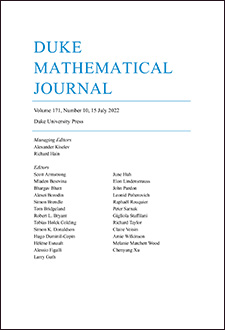Abstract
The problem of estimating the multiplicity of the zero of a polynomial when restricted to the trajectory of a nonsingular polynomial vector field, at one or several points, has been considered by authors in several different fields. The two best (incomparable) estimates are due to Gabrielov and Nesterenko.
In this paper we present a refinement of Gabrielov’s method which simultaneously improves these two estimates. Moreover, we give a geometric description of the multiplicity function in terms of certain naturally associated polar varieties, giving a topological explanation for an asymptotic phenomenon that was previously obtained by elimination-theoretic methods in the works of Brownawell, Masser, and Nesterenko. We also give estimates in terms of Newton polytopes, strongly generalizing the classical estimates.
Citation
Gal Binyamini. "Multiplicity estimates: A Morse-theoretic approach." Duke Math. J. 165 (1) 95 - 128, 15 January 2016. https://doi.org/10.1215/00127094-3165220
Information





